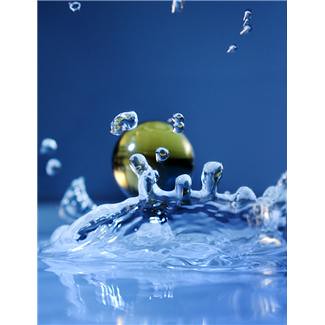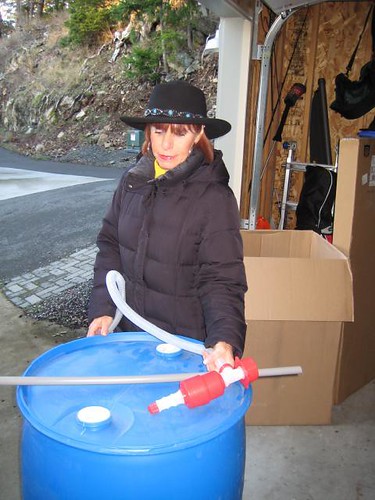Water – The Most Important Survival Basic
Clean water is something that we all take for granted. We turn on the faucet and there it is. It is plentiful, it is clean and it is drinkable. Yes, it may have some undesirable chemical additions (fluorides come to mind) but that is a subject for another day. So if a disaster occurred and the supply lines to fresh water were comprised, we would be in a pickle. There is a possibility that safe water would not be available for days and possibly not for weeks.

For this reason, the American Red Cross, FEMA, and just about every other authority out there recommends that the public store at least one gallon of water per person, per day for a minimum of three days. But if you think that a three day water supply is adequate, think again.
A more reasonable recommendation is that you up the recommended amount of stored water to a two week supply. So for two people that would be 2 people x 1 gallon x 14 days = 28 gallons. This amount should cover your minimal needs for drinking, food preparation and nominal – and I mean nominal – hygiene.
Water Storage
Storing water for an emergency can be as simple as filling thoroughly washed plastic or glass containers with tap water and sealing them tightly. This is something that anyone can do without incurring a cost so long as few simple rules are followed.
So let’s do it. Let us store some water following these steps:
1. Clean them up. Thoroughly clean your plastic bottle and jugs with dishwashing soap and water then rinse completely so there is no residual soap.
2. Sanitize with bleach. Sanitize your bottles by adding a solution of 1 teaspoon of on-scented liquid household chlorine bleach to a quart of water. Swish the sanitizing solution in the containers so that it touches all interior surfaces. Don’t forget to sanitize the lids and caps as well. After sanitizing the containers and caps, thoroughly rinse out the bleach solution with clean water.
3. Fill ‘em up. Fill them to the top with regular tap water. Add two drops of non-scented liquid household chlorine bleach to the water, then tightly close the containers using the original caps. It is probably a good idea to use some latex or nitrile gloves at this point so that you maintain the sanitation and do not contaminate the caps by touching the inside of them with your fingers.
at this point so that you maintain the sanitation and do not contaminate the caps by touching the inside of them with your fingers.
4. Date the outside with a permanent marker such as a Sharpie .
5. Store in a cool, dark place.
6. Important: rotate in six months. Dump the water, re-sanitize the jugs, and start all over. Personally, I think it would be a good idea to put up a few jugs at the first of each month. Do this for six months and you will build up a nice, rotating stock.
Plastic soda bottles or juice jugs work well for this purpose.
Water stored this way is good for six months to a year as long as it is kept in a cool, dark place. Regardless of where it is kept, the containers should be rotated at the end of the designated period.
Note: Milk jugs should not be used since the milk and protein sugars are difficult to remove and will compromise the stored water because this will provide an environment for bacteria growth. In addition, milk jugs are flimsy and will not hold up, even for a short period of time. Ditto cardboard. The cardboard will eventually leak and make a big mess. Glass is okay but be aware that glass is heavy and subject to breakage.

If you have the space and the budget, you can purchase food-grade plastic drums designed for water storage. These typically hold 55 gallons of water and with the addition of proper purification chemicals, will keep the water safe for up to five years. I personally have a 55 gallon water storage system. It was easy to set up and it came outfitted as a complete kit with all of the various tools and siphons I will need if/when that emergency situation occurs.
Another alternative, of course, is bottled water. The same rule applies: store in a cool, dark area and periodically rotate.
Hidden Sources of Water
In addition to tap water, there are other hidden sources of water that you can use when a disaster occurs. These sources include the water in your hot water heater, pipes, and even the ice cubes from the icemaker in your refrigerator or freezer. Before tapping in to these sources, however, you will first need to shut off the main valve coming in to your home so that you do not contaminate the ”good” water with the “bad”.
Here are some specific instructions for using the water in your hot water tank:
- Turn off the electricity of gas.
- Open the drain at the bottom of the tank.
- Start the water flowing by turning off the water intake valve at the tank and turning on a hot-water faucet.
- And don’t forget: be sure to refill the tank before turning the gas or electricity back on.
Outdoor Sources of Water
Barring the use of stored water or the hidden water sources in your home, there is always the outdoors. Water may be available from rainwater, streams, ponds, lakes and natural streams. But absolutely stay away from flood water since it is likely to contain sewage and other nasties that you do not even want to think about.
When using outdoor sources of water, you are going to have to undertake purification measures to make it safe. There are many ways to purify water, some better than others and some easier than others.
Continue Reading at www.backdoorsurvival.com




















